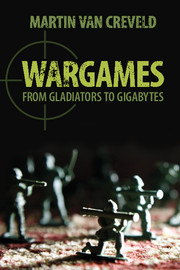Book contents
- Frontmatter
- Contents
- Acknowledgments
- Introduction
- 1 On animals and men
- 2 Games and gladiators
- 3 Trials by combat, tournaments, and duels
- 4 Battles, campaigns, wars, and politics
- 5 From bloody games to bloodless wars
- 6 Enter the computer
- 7 The females of the species
- 8 Conclusions: The mirrors and the mirrored
- Index
- References
4 - Battles, campaigns, wars, and politics
Published online by Cambridge University Press: 05 April 2013
- Frontmatter
- Contents
- Acknowledgments
- Introduction
- 1 On animals and men
- 2 Games and gladiators
- 3 Trials by combat, tournaments, and duels
- 4 Battles, campaigns, wars, and politics
- 5 From bloody games to bloodless wars
- 6 Enter the computer
- 7 The females of the species
- 8 Conclusions: The mirrors and the mirrored
- Index
- References
Summary
From squares to hexes
The wargames discussed in this volume so far were played by real men using real weapons, though admittedly some of them were blunted or otherwise modified to make them less dangerous. Either the games took place out of doors, as most did from the Stone Age on, or else they were held in special structures such as the Colosseum. Without exception, all were somewhat dangerous – danger, in fact, was precisely what set them apart from other two-sided games in which victory was won not by fighting but by other methods. Many, notably single combat, combat of champions, gladiatorial combats, trial by battle, and duels, were very dangerous indeed. In some cases this was carried to the point where the fighting was as real and as deadly as anything in war. The difference consisted in the purpose the games served; also in the ceremonies with which the games started and ended and of which they were a part.
However, between about 1450 and 1525, a vast change came over warfare, and with it wargames. Until then, practically all weapons used by all civilizations around the world had been edged and derived their energy from human muscle. This even applied to those which, like siege engines, used various contrivances in order to combine the energy of numerous individuals. The introduction of firearms, as demonstrated most convincingly at Constantinople in 1453, changed all that. On the one hand it made weapons much more powerful and much more deadly.
- Type
- Chapter
- Information
- WargamesFrom Gladiators to Gigabytes, pp. 139 - 188Publisher: Cambridge University PressPrint publication year: 2013



